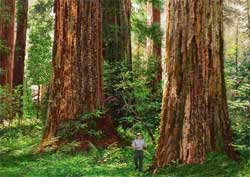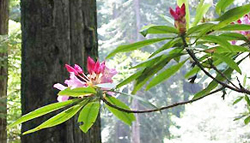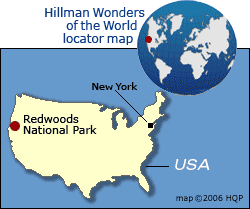Redwoods National Park
 Why the
Redwoods National Park
is special
Why the
Redwoods National Park
is specialThe redwoods are the world's tallest trees, and many of the highest ones reside in the Redwoods National Park in northern California. Some are 30-stories high and have lived for 2,000 years.
Redwoods National Park tips and insights
Bark
The redwood bark is extra thick, which helps protect the plant during forest fires. The bark is also high in tannin, which insects hate. And, the tree self-sheds all but the branches high off the ground, which also thwarts insect attack. All these factors contribute to the organism's remarkable multi-millennial longevity.
The bark is more auburn than red, but inside, the color becomes redder. This gives the tree its name.
Roots
The roots are unexpectedly shallow for such a towering life form. They rarely go deeper than 3 meters (10 feet). Instead, they broadly spread out. And, they tangle with the roots of other redwoods, which creates structural reinforcement. The need to do this is one reason why redwoods grow close together.
 Telling a redwood
from a sequoia
Telling a redwood
from a sequoiaThe Redwood and Sequoia National Parks, both Hillman Silver Medal winners, are located 800 kilometers (500 miles) apart in California. Their majestic trees are biologically close relatives, but have distinct characteristics.
- Redwoods
They are slightly taller, and have a fluted bark pattern. - Sequoias
They are greater in girth and volume, have a motley bark pattern, and live longer.
The leaves are designed to capture and condense moisture from the coastal fog during the dry season. Soon the droplets fall to the ground like rainfall to water the roots of the thirsty tree.
Reproduction
Redwoods can reproduce from seed - or by sprouting, from either live or dead trees.
Logging
The urge to conserve began in the 1800s when logging cut down most of the redwoods (its durable wood is excellent for constructing buildings).
Location in America



